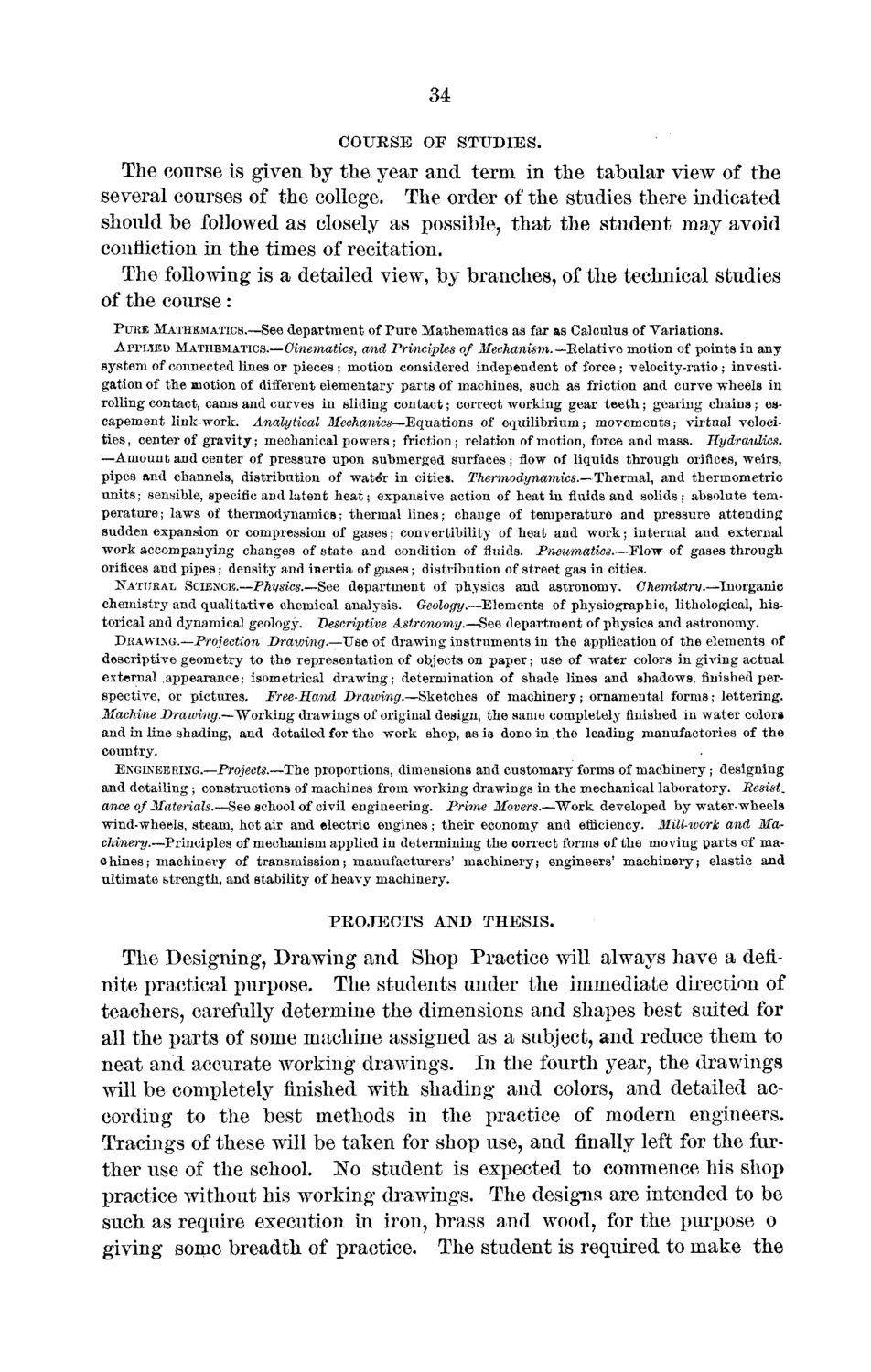| |
| |
Caption: Board of Trustees Minutes - 1872
This is a reduced-resolution page image for fast online browsing.

EXTRACTED TEXT FROM PAGE:
34 COURSE OF STUDIES. The course is given by the year and term in the tabular view of the several courses of the college. The order of the studies there indicated should be followed as closely as possible, that the student may avoid confliction in the times of recitation. The following is a detailed view, by branches, of the technical studies of the course : PURE MATHEMATICS.—See department of Pure Mathematics as far as Calculus of Variations. APPLIED MATHEMATICS.—Cinematics, and Principles of Mechanism.—Relative motion of points in any system of connected lines or pieces; motion considered independent of force ; velocity-ratio; investigation of the motion of different elementary parts of machines, such as friction and curve wheels in rolling contact, cams and curves in sliding contact; correct working gear teeth; gearing chains; escapement link-work. Analytical Mechanics—Equations of equilibrium; movements; virtual velocities, center of gravity; mechanical povrers; friction; relation of motion, force and mass. Hydraulics. —Amount and center of pressure upon submerged surfaces; now of liquids through orifices, weirs, pipes and channels, distribution of wate*r in cities. Thermodynamics.— Thermal, and thermometric units; sensible, specific and latent heat; expansive action of heat in fluids and solids; absolute temperature; laws of thermodynamics; thermal lines; change of temperature and pressure attending sudden expansion or compression of gases; convertibility of heat and work; internal and external work accompanying changes of state and condition of ihiids. Pneumatics.—Mow of gases through orifices and pipes; density and inertia of gases; distribution of street gas in cities. NATURAL SCIENCE.—Physics.—See department of physics and astronomy. Chemistry.—Inorganic chemistry and qualitative chemical analysis. Geology.—Elements of physiographic, lithological, historical and dynamical geology. Descriptive Astronomy.—See department of physics and astronomy. DRAWING.—Projection Drawing.—Use of drawing instruments in the application of the elements of descriptive geometry to the representation of objects on paper; use of water colors in giving actual external appearance; isometrical drawing; determination of shade lines and shadows, finished perspective, or pictures. Free-Hand Drawing.—Sketches of machinery; ornamental forms; lettering. Machine Drawing.—Working drawings of original design, the same completely finished in water colors and in line shading, and detailed for the work shop, as is done in the leading manufactories of the country. ENGINEERING.—Projects.—The proportions, dimensions and customary forms of machinery; designing and detailing ; constructions of machines from working drawings in the mechanical laboratory. Resist, ance of Materials.—See school of civil engineering. Prime Movers.—Work developed by water-wheels wind-wheels, steam, hot air and electric engines; their economy and efficiency. Mill-work and Machinery.—Principles of mechanism applied in determining the oorrect form3 of the moving parts of maohines; machinery of transmission; manufacturers' machinery; engineers' machinery; elastic and ultimate strength, and stability of heavy machinery. PROJECTS AND THESIS. The Designing, Drawing and Shop Practice will always have a definite practical purpose. The students under the immediate direction of teachers, carefully determine the dimensions and shapes best suited for all the parts of some machine assigned as a subject, and reduce them to neat and accurate working drawings. In the fourth year, the drawings will be completely finished with shading and colors, and detailed according to the best methods in the practice of modern engineers. Tracings of these will be taken for shop use, and finally left for the further use of the school. No student is expected to commence his shop practice without his working drawings. The designs are intended to be such as require execution in iron, brass and wood, for the purpose o giving some breadth of practice. The student is required to make the
| |